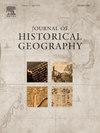From hunters to herders: Race, reindeer and imperial expansion in Alaska c.1890–1906
IF 1.3
2区 历史学
Q2 GEOGRAPHY
引用次数: 0
Abstract
This article traces the work of the American educationalist and missionary Sheldon Jackson as he introduced non-native reindeer to Northern Alaska. Jackson sought to improve what he considered to be a dire economic situation unfolding amongst the Indigenous Iñupiat community. The scheme involved recruiting Chukchi reindeer herders inhabiting the Siberian Peninsula to instruct the local Iñupiat communities on the handling and husbandry of these non-human Arctic animals. Following tensions between these Indigenous herders and the leaders of the colonial reindeer station, however, the Chukchi recruits were dismissed, and were replaced by a group of Sámi reindeer herders that Jackson had transported from Sápmi.
Drawing from recent geographical literatures that offer Indigenous perspectives on human/non-human relations, and combining these with ongoing scholarship examining colonial histories and legacies in the Arctic, this article contextualises this troubling imperial intervention amidst broader processes of nineteenth-century American territorial expansion. Studying the construction of a racialised ‘hierarchy of acceptability’ with regards to Arctic Indigenous peoples based on their relationships with non-human animals, the article critiques the problematic ‘civilizing’ mission that lay behind Jackson's colonial activities in Alaska. The article thus concludes by arguing that Jackson's reindeer project was just one of several colonial disruptions to Indigenous human/non-human relationships that were to have dire consequences across the circumpolar North.
从猎人到牧人:1890 - 1906年阿拉斯加的种族、驯鹿和帝国扩张
这篇文章追溯了美国教育家和传教士谢尔登·杰克逊将非本地驯鹿引入阿拉斯加北部的工作。杰克逊试图改善他认为是可怕的经济状况在土著Iñupiat社区展开。该计划包括招募居住在西伯利亚半岛的楚科奇驯鹿牧民,指导当地Iñupiat社区如何处理和饲养这些非人类的北极动物。然而,随着这些土著牧民和殖民地驯鹿站的领导人之间的紧张关系,楚科奇新兵被解雇了,取而代之的是杰克逊从Sápmi运来的一群Sámi驯鹿牧民。本文借鉴了最近的地理文献,这些文献提供了土著对人类/非人类关系的看法,并结合了正在进行的研究北极殖民历史和遗产的学术研究,将这种令人不安的帝国干预置于19世纪美国领土扩张的更广泛过程中。这篇文章基于北极原住民与非人类动物的关系,研究了他们种族化的“可接受等级”的构建,批评了杰克逊在阿拉斯加殖民活动背后存在问题的“文明”使命。因此,文章的结论是,杰克逊的驯鹿项目只是对土著人类/非人类关系的几次殖民破坏之一,这些破坏对整个环北极地区造成了可怕的后果。
本文章由计算机程序翻译,如有差异,请以英文原文为准。
求助全文
约1分钟内获得全文
求助全文
来源期刊

Journal of Historical Geography
Multiple-
CiteScore
1.50
自引率
10.00%
发文量
53
期刊介绍:
A well-established international quarterly, the Journal of Historical Geography publishes articles on all aspects of historical geography and cognate fields, including environmental history. As well as publishing original research papers of interest to a wide international and interdisciplinary readership, the journal encourages lively discussion of methodological and conceptual issues and debates over new challenges facing researchers in the field. Each issue includes a substantial book review section.
 求助内容:
求助内容: 应助结果提醒方式:
应助结果提醒方式:


